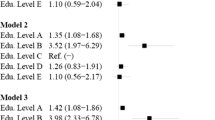Summary.
Objectives: To evaluate the size of social inequities in health between regions in Belgium using a composite health measure, the disability free life expectancy (DFLE).
Methods: Mortality data (5-years follow-up of the 1991 census) are combined with the 1997 Health Interview Survey to estimate the DFLE by education. Differences in partial life expectancy25–74 (LE25–74) and in DFLE25–74 between those at the bottom and those at the top of a relative social scale are used to compare the regional inequities.
Results: The higher educated person has a longer LE, with more years free of disability and less years with disability (in years: Flemish males: LE = 46.48; DFLE = 42.08; Walloon males: LE = 44.92; DFLE = 39.80; Flemish females: LE = 47.90; DFLE =41.93; Walloon females: LE = 46.90; DFLE = 39.84) compared to the population at the bottom of the education hierarchy (in years: Flemish males: LE = 44.86; DFLE = 30.16; Walloon males: LE = 42.77; DFLE = 27.00; Flemish females: LE = 46.86; DFLE =28.30; Walloon females: LE = 45.44; DFLE = 25.30). The inequity in LE and in DFLE is larger in the Walloon Region than in the Flemish Region. Only the regional difference in inequity in LE is statistically significant.
Conclusion: The DFLE can be used to monitor the size of health inequities.
Zusammenfassung.
Ungleichheiten der Gesundheits- und Lebenserwartung in den zwei Regionen in Belgien
Fragestellung: Evaluieren der Ungleichheiten der Gesundheitsund Lebenserwartungen zwischen den zwei belgischen Regionen mittels eines zusammengestellten Gesundheitsmasses, der Lebenserwartung ohne Behinderung (DFLE).
Methoden: Sterbetafeln (Follow-up-Studie fünf Jahre nach der Volkszählung 1991) werden mit der Gesundheitsbefragung 1997 kombiniert zur Schätzung der DFLE nach Ausbildung. Unterschiedliche Teillebenserwartung25–74 (LE25–74) und DFLE25–74 zwischen der obersten und der ersten “Sprosse” der sozialen Leiter werden benutzt zum Vergleich der regionalen vertikalen Ungleichheiten.
Ergebnisse: Höher ausgebildete Personen haben eine höhere Lebenserwartung mit mehr Jahren ohne Behinderung und weniger Jahren mit Behinderung (in Jahren angegeben: flämische Männer: LE = 46,48; DFLE = 42,08; wallonische Männer: LE = 44,92; DFLE = 39,80; flämische Frauen: LE = 47,90; DFLE = 41,93; wallonische Frauen: LE = 46,90; DFLE = 39,84) als die Personen am anderen Ende des Spektrums (in Jahren angegeben: flämische Männer: LE = 44,86; DFLE = 30,16; wallonische Männer: LE = 42,77; DFLE = 27,00; flämische Frauen: LE = 46,86; DFLE = 28,30; wallonische Frauen: LE = 45,44; DFLE = 25,30). Die vertikale Ungleichheit in der LE und der DFLE ist in der wallonischen Region grösser als in der flämischen. Nur der regionale Unterschied in der vertikalen Ungleichheit der LE ist statistisch signifikant.
Schlussfolgerung: Die DFLE kann zur Berechnung der Ungleichheiten der Gesundheits- und Lebenserwartungen angewandt werden.
Résumé.
Différences d’inégalités d’espérance de vie par région en Belgique
Objectifs : Évaluer l’importance des inégalités sociales de santé entre les régions en Belgique sur base d’une mesure de santé composite, l’espérance de vie sans incapacité (EVSI).
Méthodes : Les données de mortalité (suivi du recensement de 1991 après cinq ans) ont été combinées avec les données de l’enquête de santé par interview de 1997 afin d’estimer l’EVSI en fonction du niveau d’éducation. Les différences d’espérance de vie partielle25–74 (EV25–74) et d’EVSI25–74 entre les personnes situées en bas et en haut d’une échelle sociale relative ont été utilisées pour comparer les inégalités régionales.
Résultats : Les personnes ayant un niveau d’éducation plus élevé ont une plus grande EV avec plus d’années sans incapacité et moins d’années avec des incapacités (en années: hommes en Flandre: EV = 46,48; EVSI = 42,08; hommes en Wallonie: EV = 44,92; EVSI = 39,80; femmes en Flandre: EV = 47,90; EVSI = 41,93; femmes en Wallonie: EV = 46,90; EVSI = 39,84) par rapport à la population ayant un niveau d’éducation moins élevé (en années: hommes en Flandre: EV = 44,86; EVSI = 30,16; hommes en Wallonie: EV = 42,77; EVSI = 27,00; femmes en Flandre: EV = 46,86; EVSI = 28,30; femmes en Wallonie: EV = 45,44; EVSI = 25,30). L’inégalité de l’EV et de l’EVSI est plus importante en Région wallonne qu’en Région flamande. Seule la différence régionale de l’inégalité quant à l’espérance de vie est statistiquement significative.
Conclusion : L’EVSI peut être utilisée pour le suivi de l’importance des inégalités de santé.
Similar content being viewed by others
Author information
Authors and Affiliations
Corresponding author
Additional information
An erratum to this article is available at http://dx.doi.org/10.1007/s00038-005-0013-9.
Rights and permissions
About this article
Cite this article
Oyen, H.V., Bossuyt, N., Deboosere, P. et al. Differential inequity in health expectancy by region in Belgium. Soz.-Präventivmed. 50, 301–310 (2005). https://doi.org/10.1007/s00038-005-5017-y
Received:
Accepted:
Published:
Issue Date:
DOI: https://doi.org/10.1007/s00038-005-5017-y




